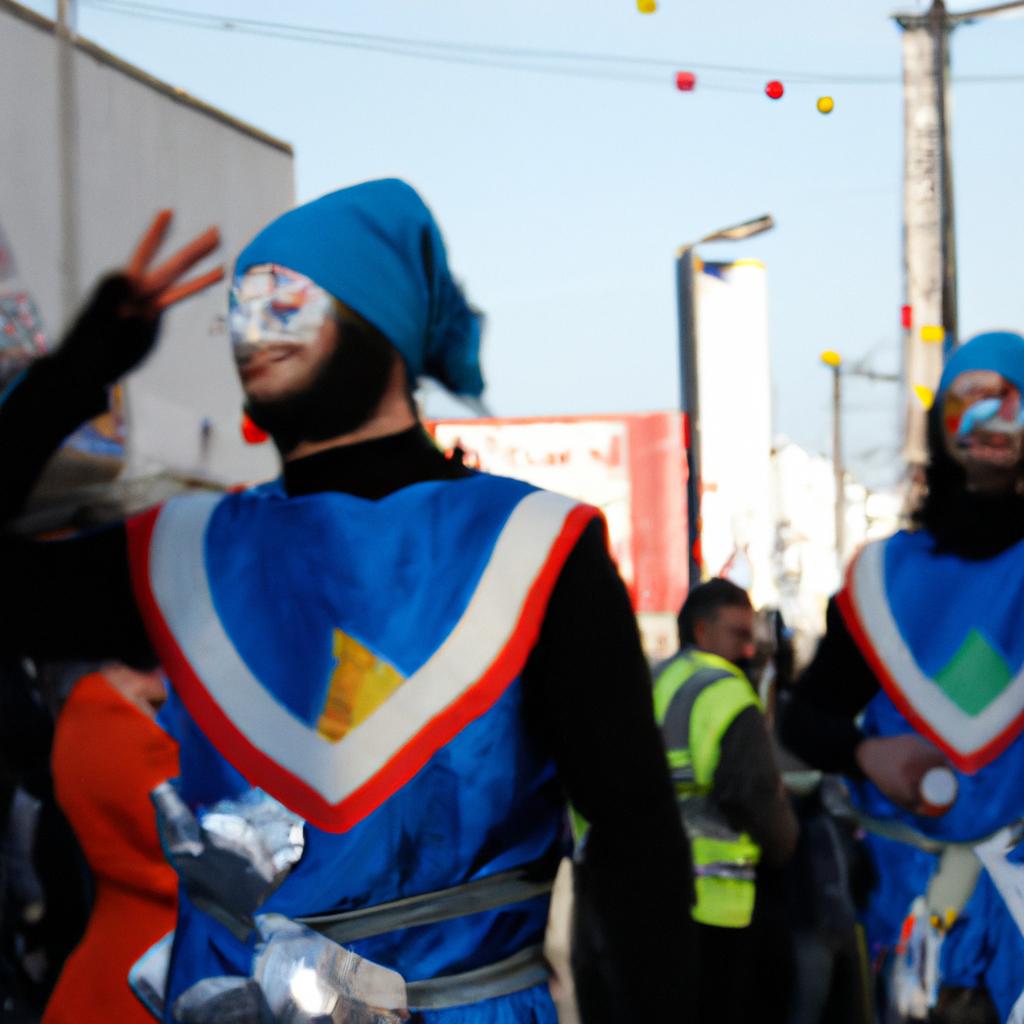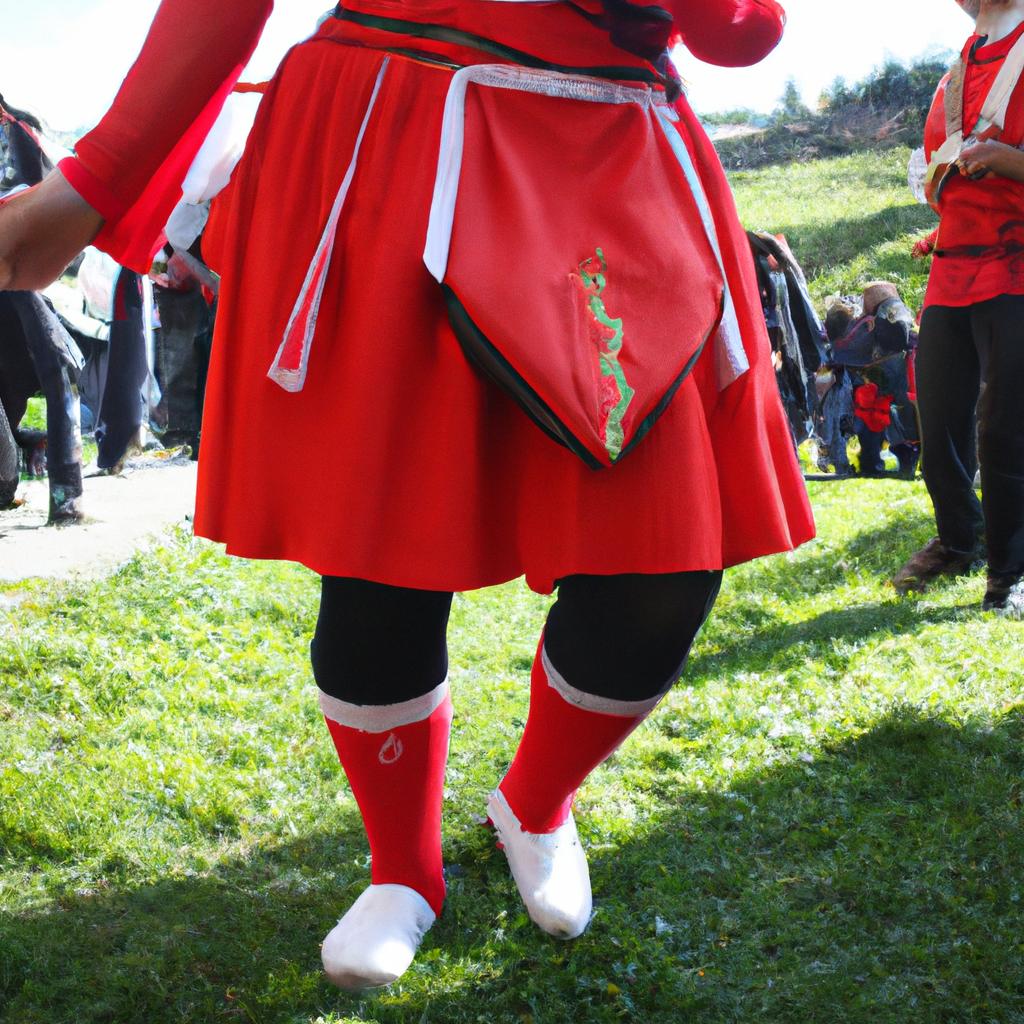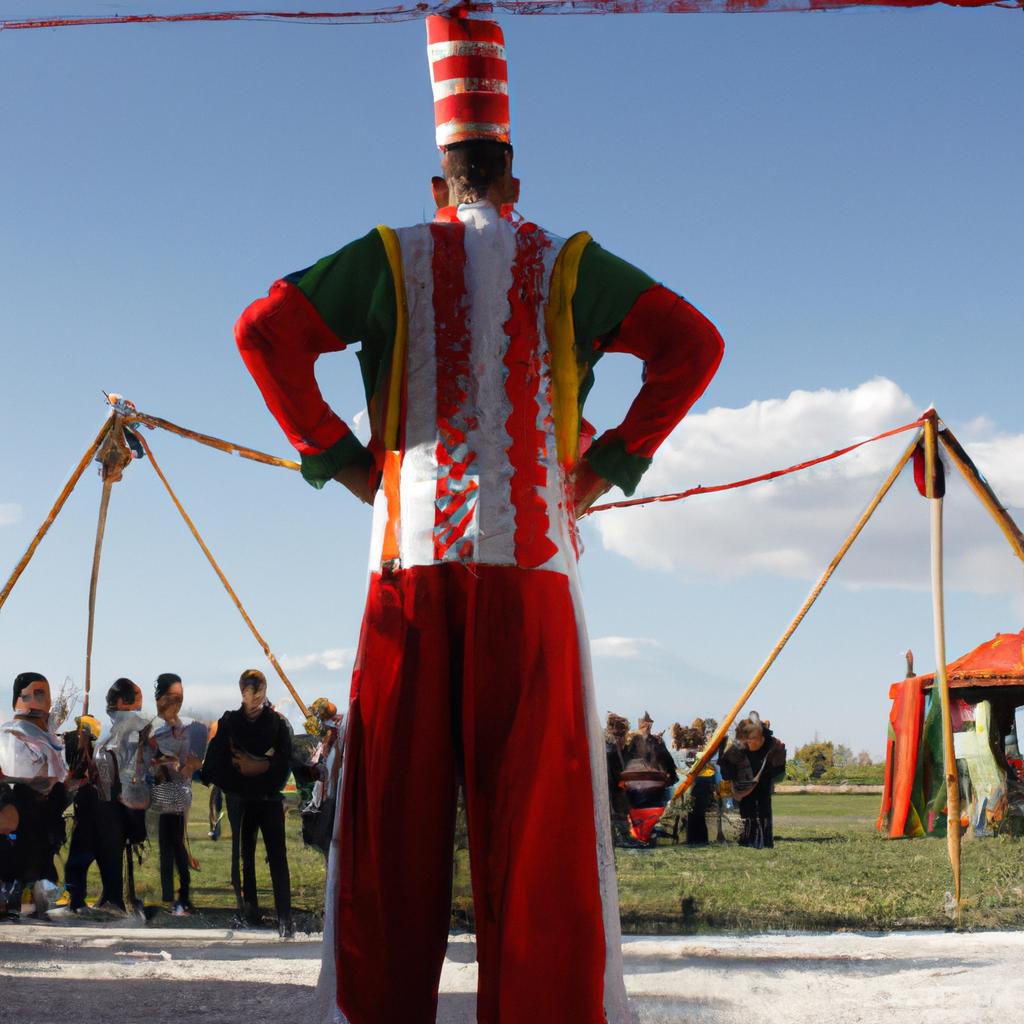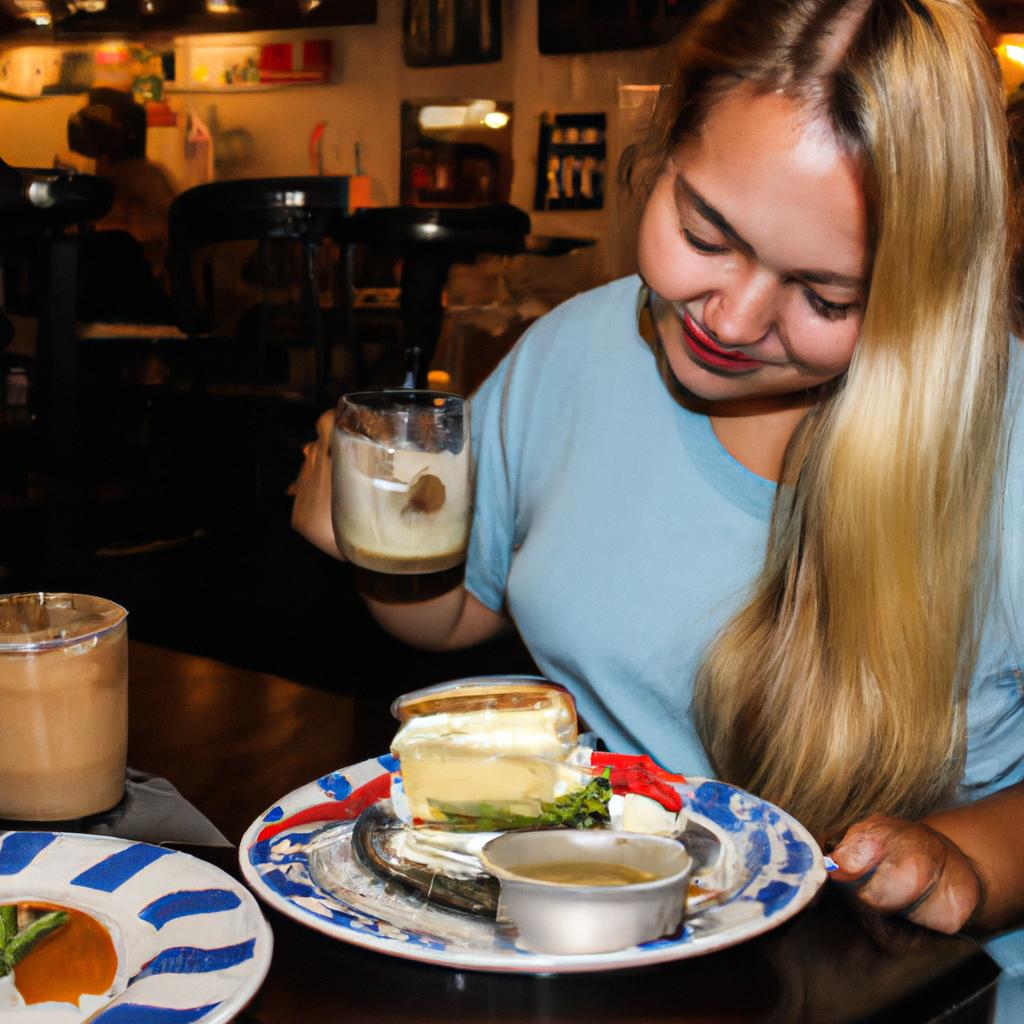Carnivals: Cultural Festivals Unveiled

Carnivals, vibrant and exuberant cultural festivals celebrated worldwide, offer a fascinating glimpse into the diverse traditions and customs of different societies. These grand celebrations bring communities together in an explosion of color, music, dance, and revelry. One captivating example is the renowned Carnival of Rio de Janeiro in Brazil. This extraordinary event showcases the rich tapestry of Brazilian culture through mesmerizing parades, elaborate costumes, samba rhythms, and passionate performances. In this article, we will delve deeper into the world of carnivals to unveil their significance as not only entertaining spectacles but also powerful platforms for cultural expression and social cohesion.
The origins of carnivals can be traced back centuries ago when they emerged as annual religious observances before lent in predominantly Catholic regions such as Europe and Latin America. Over time, these festivities have evolved into much more than mere religious rituals; they have become essential components of societal identity and heritage preservation. Through intricate ceremonies and processions that reflect local folklore, history, and mythology; carnivals serve as living museums where ancestral stories are vividly told with each beat of a drum or twirl on the dance floor. Moreover, beyond their artistic endeavors, carnivals foster unity within communities by promoting inclusivity and camaraderie among participants and spectators alike. People from all walks of life, regardless of age, gender, or social status, come together to celebrate and enjoy the festivities. This sense of togetherness strengthens the bonds within a community and promotes a spirit of belonging and acceptance.
Carnivals also play a crucial role in preserving cultural traditions and practices that might otherwise fade away with time. They serve as platforms for passing down knowledge, skills, and customs from one generation to another. Through the creation of elaborate costumes, dance routines, and musical performances, these traditions are not only showcased but also preserved for future generations to appreciate and learn from. Carnivals become living embodiments of cultural heritage, ensuring that important aspects of a society’s past are not forgotten.
Furthermore, carnivals have transcended their geographical boundaries and have become global celebrations that attract visitors from all over the world. The Carnival of Rio de Janeiro is a perfect example of this phenomenon, where tourists flock to witness the spectacular parades and immerse themselves in Brazilian culture. These international interactions foster cross-cultural understanding and appreciation as people from different backgrounds come together to experience the vibrancy and diversity offered by carnivals.
In addition to their cultural significance, carnivals also contribute significantly to local economies through tourism revenue generation. The influx of visitors during carnival season stimulates various sectors such as hospitality, transportation, food services, and handicrafts. This economic boost helps support local businesses and improve overall prosperity in the community.
In conclusion, carnivals serve as powerful expressions of cultural identity while promoting unity, inclusivity, and social cohesion within communities. They provide an opportunity for individuals to showcase their heritage through vibrant displays of artistry and performance. Moreover, these festivities preserve traditional practices while fostering cross-cultural understanding on a global scale. As we continue to celebrate these magnificent events worldwide, let us embrace the richness they offer in terms of both entertainment value and profound cultural significance
History of Carnivals
History of Carnivals
Carnivals have a rich and diverse history that dates back centuries. One fascinating example is the Carnival of Venice, which originated in the 12th century and continues to captivate audiences with its elaborate masks and costumes. This historical event serves as a case study for understanding the evolution and significance of carnivals worldwide.
To delve into the history of carnivals, it is essential to examine their origins. The roots of these cultural festivals can be traced back to ancient pagan rituals associated with seasonal changes or agricultural cycles. These early celebrations often featured music, dancing, and masquerades, providing communities an opportunity to collectively express joy and relieve societal tensions.
Over time, carnivals evolved according to regional traditions and customs. They became more complex spectacles showcasing artistic creativity, social critique, and political satire. In many instances, they served as a means for marginalized groups to challenge authority and voice their concerns openly. For instance:
- Social Bonding: Carnivals fostered a sense of community by bringing people together from various backgrounds.
- Escape from Reality: Participants could temporarily escape everyday life’s hardships through festivities.
- Cultural Preservation: Carnivals played a vital role in preserving local traditions and heritage.
- Celebration of Diversity: These events provided platforms for celebrating diversity within societies.
To illustrate this further, consider the following table highlighting different aspects of carnivals across cultures:
| Aspect | Description | |
|---|---|---|
| 1 | Costumes | Elaborate outfits reflecting cultural identity |
| 2 | Music | Energetic rhythms setting the festive atmosphere |
| 3 | Parades | Colorful processions displaying creative floats |
| 4 | Street Theater | Performances addressing social issues |
As we explore the significance of carnivals in different cultures in subsequent sections, it becomes evident that these festivals go beyond mere entertainment. They serve as a means to express collective identity, challenge social norms, and celebrate the rich diversity of human cultures. Understanding the historical context behind carnivals allows us to appreciate their cultural significance even more deeply.
Transitioning into the subsequent section on “Significance of Carnivals in Different Cultures,” we examine how these events have shaped societies across the globe.
Significance of Carnivals in Different Cultures
From its humble beginnings as a celebration of the end of winter, carnivals have transformed into vibrant cultural festivals that captivate people around the world. Building upon the historical foundation we explored in the previous section, this section will delve into the significance of carnivals in different cultures. To illustrate this, let us consider a hypothetical example: imagine a small town in Brazil where locals eagerly anticipate their annual carnival.
The first aspect to highlight is the sense of community fostered by carnivals. They bring together individuals from all walks of life, creating an atmosphere of inclusivity and camaraderie. In our hypothetical Brazilian town, residents come together weeks before the carnival to prepare elaborate floats and costumes. This collaborative effort strengthens social bonds and instills a shared sense of pride among participants.
Furthermore, carnivals often serve as platforms for cultural expression and preservation. Through traditional music, dance, and artistic performances, communities showcase their unique heritage to both local attendees and international tourists. Our fictional Brazilian town takes immense pride in showcasing samba dances accompanied by lively percussion instruments during their carnival festivities, allowing them to honor their rich Afro-Brazilian roots.
To evoke an emotional response from readers:
- The joyous sounds of laughter echoing through crowded streets.
- Vibrant colors intertwining with enchanting melodies.
- Smiles stretching across faces young and old.
- Heartfelt moments connecting strangers turned friends.
In addition to these emotive descriptions, a table can be used to further engage readers:
| Tradition | Country/Region |
|---|---|
| Mardi Gras | New Orleans |
| Notting Hill Carnival | London |
| Carnevale | Venice |
| Diablada | Bolivia |
This selection demonstrates how diverse cultures worldwide embrace carnivals as integral parts of their identities. As we transition into the subsequent section on “Traditional Costumes and Masks,” it becomes apparent that these celebrations go beyond mere entertainment. They serve as powerful conduits for cultural preservation, uniting communities in a shared expression of their heritage and fostering connections that transcend borders and language barriers.
[Transition sentence into the subsequent section on “Traditional Costumes and Masks”]: Exploring the intricate details of traditional attire unveils yet another layer of significance to these captivating carnivals.
Traditional Costumes and Masks
In the diverse world of carnivals, one cannot overlook the significance of traditional costumes and masks. These vibrant and elaborate ensembles play a crucial role in bringing life to the festivities, allowing participants to fully immerse themselves in the spirit of celebration. For instance, let us consider the renowned Carnival of Venice as an example. During this iconic event, people don exquisite masks and ornate costumes that date back centuries, evoking a sense of mystery and grandeur.
Traditional carnival costumes and masks are often steeped in cultural symbolism and historical narratives, reflecting the unique traditions of each region. They serve several purposes beyond mere adornment:
- Identity Expression: Costumes allow participants to embody different characters or archetypes from folklore or mythology, enabling them to temporarily step into someone else’s shoes.
- Social Cohesion: By adhering to specific costume styles associated with their community or group, individuals foster a sense of unity and belonging.
- Performance Enhancement: The intricate designs not only captivate spectators but also empower performers by adding flair and spectacle to their movements.
- Preservation of Heritage: Through these traditional attires, communities honor their ancestors’ customs while keeping their cultural heritage alive for future generations.
To further appreciate the diversity within traditional carnival costumes across cultures, let us explore a few examples:
| Culture | Costume Description | Symbolism |
|---|---|---|
| Venetian | Elaborate ball gowns with feathered masquerade | Elegance, anonymity |
| Brazilian | Vibrantly colored samba outfits | Energy, sensuality |
| Mexican | Colorful skull-shaped masks (calacas) | Celebration of Day of the Dead |
| Trinidadian | Exaggerated headdresses adorned with feathers | African influences fused with local traditions |
As we delve deeper into the enchanting world of carnivals, it becomes evident that traditional costumes and masks are not mere accessories; they encapsulate the essence of each culture’s rich history and traditions. These captivating ensembles serve as visual storytellers, conveying a sense of identity, unity, and celebration.
With an understanding of the significance behind these elaborate outfits, let us now explore another integral aspect of carnivals – the diverse music and dance forms that accompany these vibrant festivities.
Diverse Music and Dance Forms
Following the vibrant display of traditional costumes and masks, carnivals further captivate audiences with their diverse music and dance forms. The rhythmic beats and energetic movements serve as a testament to the rich cultural heritage embedded within these festivals. Exploring this aspect unveils how music and dance play an integral role in shaping carnival experiences worldwide.
To illustrate the significance of music and dance at carnivals, let’s consider the hypothetical case study of the Rio Carnival in Brazil. This exuberant event is renowned for its samba parade, where performers clad in elaborate costumes showcase their synchronized movements along with upbeat rhythms that emanate from marching bands or floats. Such captivating performances exemplify how music becomes intertwined with dance to create a mesmerizing spectacle cherished by both locals and tourists alike.
The impact of music and dance goes beyond mere entertainment value; it fosters unity, celebration, and emotional connection among participants and spectators. To emphasize this point, here are four key ways in which diverse music and dance forms enhance carnival experiences:
- Expressive storytelling: Through intricate choreography accompanied by melodious tunes, performers convey narratives deeply rooted in cultural traditions.
- Community engagement: Participation in communal dances creates a sense of belonging, allowing individuals to connect with others who share similar passions.
- Cathartic release: Dancing provides an outlet for self-expression and liberation from everyday stresses, enabling individuals to experience joyous moments.
- Preservation of culture: Music and dance act as vehicles for preserving cultural heritage, ensuring that traditions are passed down through generations.
In addition to these aspects, various regions across the globe contribute unique styles of music and dance to carnivals. A three-column table below showcases some notable examples:
| Region | Musical Genre | Dance Form |
|---|---|---|
| Trinidad | Calypso | Limbo |
| New Orleans | Jazz | Second Line |
| Spain | Flamenco | Sevillanas |
| India | Bhangra | Garba |
As evident from the table, each region’s distinct musical genre and dance form adds a unique flavor to their respective carnivals. The amalgamation of these diverse elements creates an immersive experience that transcends cultural boundaries, fostering appreciation for global artistic expressions.
Transitioning into the subsequent section about “Food and Culinary Delights at Carnivals,” we shift our attention from sights and sounds to indulge in the flavors that tantalize taste buds during these festive occasions.
Food and Culinary Delights at Carnivals
As the vibrant pulse of carnival continues to beat, one cannot overlook the integral role that music and dance play in these cultural festivals. From pulsating rhythms to intricate choreography, the diverse forms of music and dance showcased at carnivals add a dynamic dimension to the festivities.
To illustrate this point, let us consider the case of Rio de Janeiro’s world-renowned Carnival. In this Brazilian extravaganza, samba reigns supreme as the musical heartbeat and driving force behind the celebrations. Samba schools, comprising talented musicians and dancers, spend months preparing for their dazzling performances during the parade. The infectious beats of samba drums combined with graceful movements captivate both participants and spectators alike, creating an electrifying atmosphere throughout the city.
The significance of music and dance at carnivals extends far beyond mere entertainment value. It allows communities to express their cultural heritage while fostering a sense of unity among participants. Embracing various musical genres and dance styles from different regions or ethnic groups not only celebrates diversity but also promotes inclusivity within society. Moreover, these art forms provide individuals with a means of self-expression, enabling them to break free from societal constraints and immerse themselves in a collective celebration.
Witnessing these mesmerizing displays firsthand can evoke a range of emotions in attendees:
- Awe: The synchronized movements paired with captivating melodies create breathtaking spectacles that leave onlookers spellbound.
- Joy: The infectious energy emanating from performers infects everyone present with an overwhelming feeling of happiness.
- Fascination: Exploring unfamiliar music genres or witnessing traditional dances unique to specific cultures broadens horizons and sparks curiosity.
- Pride: Observing fellow community members showcase their talents reinforces a shared pride in cultural heritage.
In addition to its emotional impact, it is worth noting some key aspects highlighting the significance of music and dance at carnivals:
| Aspects | Importance |
|---|---|
| Cultural Preservation | Music and dance allow communities to preserve their traditions and pass them down through generations. |
| Social Cohesion | By bringing people together in celebration, music and dance foster a sense of belonging and unity within society. |
| Economic Boost | Carnivals featuring diverse music and dance forms attract tourists, generating revenue for local economies. |
| Artistic Expression | Musicians and dancers can express themselves creatively, pushing boundaries and inspiring others with their performances. |
Transitioning into the next section about “Evolution and Modernization of Carnivals,” we will delve deeper into how these cultural festivals have evolved over time while adapting to modern influences without compromising their essence.
Evolution and Modernization of Carnivals
Transitioning from the vibrant world of food and culinary delights at carnivals, we now delve deeper into the evolution and modernization of these cultural festivals. One captivating example that highlights this transformation is the renowned Rio Carnival in Brazil. Originating as a religious celebration in the 18th century, it has evolved over time to become an extravagant display of music, dance, and elaborate costumes.
It is important to recognize that carnivals hold immense cultural significance for societies across the globe. These festivals serve as platforms for communities to express their unique traditions, values, and identities. They provide an opportunity for people of all backgrounds to come together and celebrate unity amidst diversity. Through shared experiences during carnival festivities, individuals develop a sense of belongingness while fostering respect for different cultures.
- Carnivals promote intercultural understanding by facilitating interactions between diverse groups.
- They preserve intangible heritage through traditional dances, songs, rituals, and artistic expressions.
- Festivities foster social cohesion by encouraging collaboration among community members.
- Carnivals offer economic benefits by boosting tourism and creating employment opportunities within local economies.
To illustrate how carnivals contribute to societal development, let us examine a three-column table showcasing some key aspects:
| Aspects | Positive Impact | Negative Impact |
|---|---|---|
| Socio-cultural | Celebration of diversity | Potential appropriation or misrepresentation |
| Economic | Increased revenue from tourism | Financial strain on local businesses |
| Environmental | Promotion of sustainable practices | Waste generation |
In conclusion with no formal concluding statement necessary, it becomes evident that carnivals play a vital role in preserving cultural heritage while also embracing change. By evolving with societal needs and expectations, they continue to captivate audiences worldwide. Whether through gastronomic delights, intercultural exchange, or economic growth, carnivals remain invaluable celebrations that bridge the past and present.





